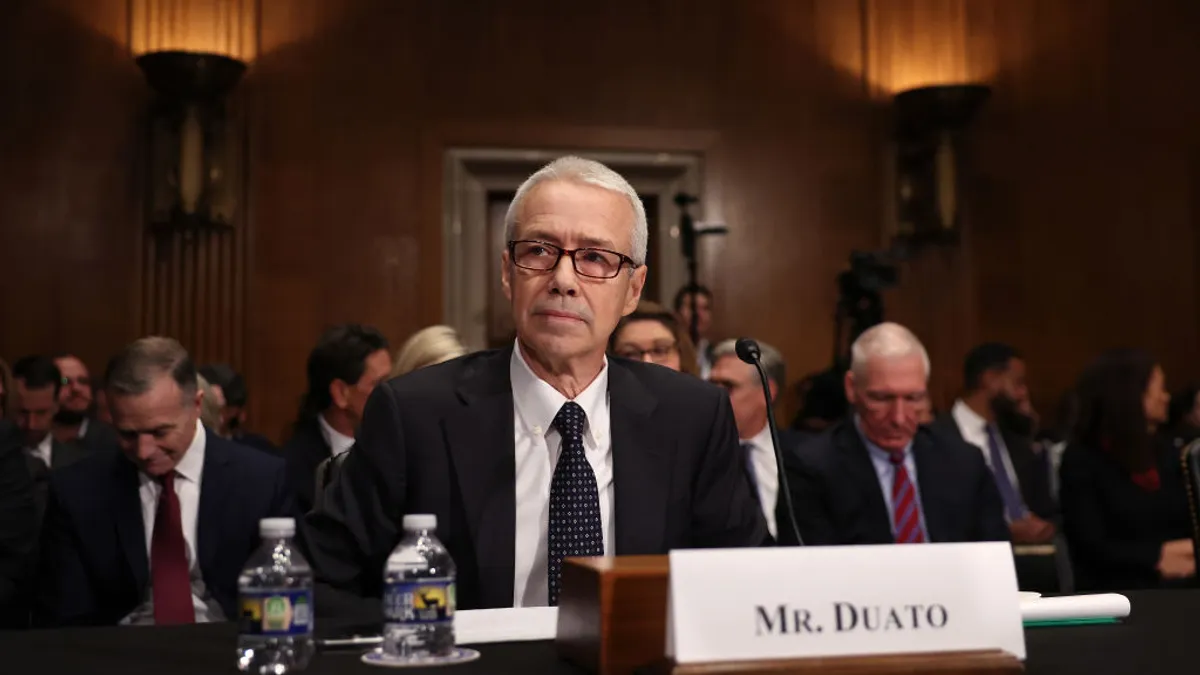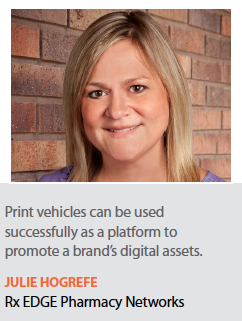 As challenging as creating a great piece of marketing is, over the years some pharma brands have still managed to nail it. According to a 2016 AdWeek CMO report, there are several examples of award-winning, but most importantly, memorable campaigns over the years that have successfully boosted brand recognition and as a result increased product lift. AdWeek’s report highlighted several such memorable campaigns, including Pfizer’s 2001 Zoloft campaign; Lilly’s 2003 Cialis effort; and Takeda’s 2007 Rozerem ads.
As challenging as creating a great piece of marketing is, over the years some pharma brands have still managed to nail it. According to a 2016 AdWeek CMO report, there are several examples of award-winning, but most importantly, memorable campaigns over the years that have successfully boosted brand recognition and as a result increased product lift. AdWeek’s report highlighted several such memorable campaigns, including Pfizer’s 2001 Zoloft campaign; Lilly’s 2003 Cialis effort; and Takeda’s 2007 Rozerem ads.
However, those campaigns were produced in a different environment, and in today’s 2017 marketing world, the struggle to hit that one great idea out of the park is further complicated by the addition of digital channels, which add a layer of complexity — and effectiveness — to the creative design. Digital has evolved from an add-on channel to becoming incorporated into pharma campaigns from the get-go, and this new practice has greatly influenced the creative process.
In today’s digital-first environment, the creative bar has been set much higher, says Phil Scherer, senior VP, group creative director, at JUICE.
“We’ve come a long way from thinking about campaigns as a static surface and a core visual aid because that simply doesn’t reflect the reality of how our customers interact with a brand," he says. “They are busy, demanding people, and the way they experience branded communication is so much faster, so much more in their control, that the creative has to work harder than ever to engage, compete for, and earn attention. The creative has to be faster and more compelling. It needs to be memorable and identifiable to the brand. At the same time, it needs to get out of the way quickly once it’s done its job, so customers can easily get real value from the communication before they move on."
For pharma advertisers, the emergence of digital as an elite channel introduced complexities that made it more challenging but also 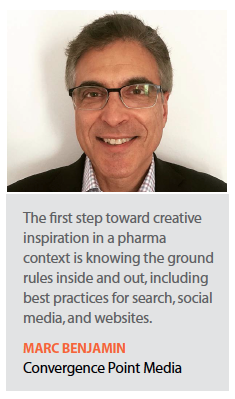 potentially more rewarding than offline channels, says Marc Benjamin, CEO, at Convergence Point Media.
potentially more rewarding than offline channels, says Marc Benjamin, CEO, at Convergence Point Media.
“Back when digital was a value-add throw-in by ad-supported publishers, a brand’s marketing assets took the form of an unruly amalgam of sales brochures, direct mail, old-school detailing materials, point-of-care materials and first-generation websites, many derided as ‘online brochures,’" he says. “Because digital creative can and should be integrated with a central online repository of key brand data living on its website and other digital hubs, the opportunities for alignment of audience members, ad messaging and destination touchpoints give rise to strategic opportunities for integration. Harvesting these opportunities calls for deeper segmentation and a wider array of creative versioning."
A digital strategy has also become a much more important player early in the process, providing big input into the brief.
“If the team has the strategy front-of-mind as it generates creative, amazing ideas for digital tactics come directly out of the work," Mr. Scherer says. “It’s really exciting for the team when great creative is conceived in tandem with a digital tactic or program and then you get to bring that to life. There’s a two-way street — the creative ideas for initiatives and tactics become an input for the strategy team as they continue developing the plan."
In order to maximize the value of digital content, the creative idea must incorporate content that can and will be shared online. For example, in 2015, GSK Consumer Healthcare began using more digital content to promote Flonase. The storyline featured the popular social media Eh Bee family on an allergy-free vacation, which included guest appearances by country star Kellie Pickler.
Viewers could follow the adventure online, while adding their own photos to Instagram. The campaign garnered 108 million Instagram likes. The abundant online sharing of its creative content resulted in Flonase becoming the No. 1 allergy remedy sold on Amazon, according to AdWeek. Building a cohesive approach across all media, GSK used TV commercials to spark awareness, which led consumers to digital content that more deeply explained how Flonase worked and created an opportunity to engage consumers in a two-way dialogue.
The addition of a digital channel shouldn’t drive the whole concept behind the creative process, but whether the idea can successfully be brought to life in the digital channel should definitely be a consideration. The creative process is still the same as it ever was, says Barry Schmader, chief creative officer, at Elevate Healthcare Marketing.
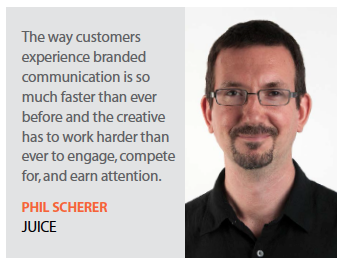 “However, today the core brand idea must translate powerfully into a 1,334 x 750 pixel canvas," he says. “Therefore, careful thought is required whether the brand and the concept will travel responsibly throughout the digital ecosystem."
“However, today the core brand idea must translate powerfully into a 1,334 x 750 pixel canvas," he says. “Therefore, careful thought is required whether the brand and the concept will travel responsibly throughout the digital ecosystem."
While creating a cohesive message that works across all channels can be challenging, traditional channels and digital can work together to complement each other.
“Print vehicles can be used as a platform to promote a brand’s digital assets — an app the consumer can download, a link to a savings offer, a sign-up for a patient support program, a digitally based symptom tracker," says Julie Hogrefe, creative director, Rx EDGE Pharmacy Networks.
However, marketers need to strive to be consistent with the positioning, tone, and look of other brand elements so that key messages are maximized across channels.
“From a creative process standpoint, cohesiveness is the key thing to keep in mind now and will continue to be valued in the future," Ms. Hogrefe says. “We always strive to connect the messages we develop for the pharmacy channel with other creative that the consumer may be seeing elsewhere, whether it’s digital, social, TV, or print."
Concepts that will work in digital and across other channels require a different lens, says Mr. Scherer, one that looks beyond just a key visual and a campaign line.
“We need a platform for storytelling," he says. “Customers are going to see the campaign across so many channels in these little chunks of engagement strung out over time, and that means the creative needs to serve as a kind of through-line linking it all together."
Key visuals will exist but marketers need the flexibility to iterate across channels. Using a range of executions with variations on the theme, marketers should strive to bring a consistent voice with identifiable elements, which has the ability to speak to a wide variety of topics, across every part of the story.
Incorporating a Digital Experience
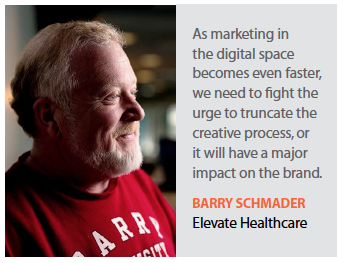 A well-integrated marketing campaign includes a strong media strategy that defines key patient and professional “perspectives" on treatment for the pertinent disease state, and the corresponding audience preferences for information gathering — this becomes the starting point for an enlightened creative roadmap, informed with both channel and messaging propensities.
A well-integrated marketing campaign includes a strong media strategy that defines key patient and professional “perspectives" on treatment for the pertinent disease state, and the corresponding audience preferences for information gathering — this becomes the starting point for an enlightened creative roadmap, informed with both channel and messaging propensities.
One of the biggest mistakes pharma marketers make is developing too few digital creative versions to effectively engage key audience subgroups, even individual audience members, for whom A/B testing can easily determine the most effective ad versioning.
“As a pharma agency executive, I can appreciate that brands prioritize working media dollars to maximize reach and frequency against their core audiences," Mr. Benjamin says. “However, that investment can be hamstrung if it comes absent a suitably robust creative rotation with dedicated executions shown to resonate with key audience segmentations."
The many different tactical options that digital provides can be distracting from the main goal of the creative process, which is to create a memorable concept that will showcase the brand message while telling a story that engages consumers. In some cases, the lure of the new spectrum of digital has supplanted implementing a core brand idea. Tactical execution becomes a proxy for a campaign.
“As marketing in the digital space becomes more immediate and even faster, we need to fight the urge to truncate the creative process, or it will have a major impact on the brand," Mr. Schmader says. “As creatives, we have never had more platforms at our disposal to build, execute, and optimize digital experiences. It’s tough — but necessary — to keep up and stay ahead of the curve."
Using digital also brings with it a fair amount of risk, and in a risk-adverse culture of the pharma industry, that can stymie the creative process.
Additionally, there’s the burden of regulatory review and the rigid processes that impede speed to market that can make it difficult to get updates out frequently and achieve a good cadence across the strategic and creative plan.
But, experts say, the bigger challenge may be in getting top-down buy-in to allow creative to go places it hasn’t before, and to move away from the tried and true, and take a chance on something outside of the traditional channel box.
“Great digital work involves taking some risks, and that can be difficult when you have established norms that offer the perception of safety," Mr. Scherer says. “Take concept testing for example, many marketers are still looking for a winning concept based on a single-surface execution; that worked for the old journal-ad-and-visaid model, but it’s not suited to the multifaceted campaigns of today." (PV)
~~~~~~~~~~~~~~~~~~~~~~~~~
The Health Chat Transformation
Chris Duffey, Global Director of Creative Technology,Sudler & Hennessey
 One of the biggest transformations in building campaigns of the future is the expansion of the definition of “creative." Specifically, the need to shift from a mindset of promotional to service-based communications in healthcare. An example of this is seen in the success and ongoing development of Chatbot technology.
One of the biggest transformations in building campaigns of the future is the expansion of the definition of “creative." Specifically, the need to shift from a mindset of promotional to service-based communications in healthcare. An example of this is seen in the success and ongoing development of Chatbot technology.
Chatbots essentially simulate conversation via voice or text commands, and at their best, are powered by artificial intelligence, which enables the bots to get smarter as they learn from conversations they has with users. As a result, physicians, patients, and health-information seekers are able to have valuable and ongoing informative exchanges and brands can share relevant health information.
Chatbots are an extraordinary business opportunity for launching innovative brand experiences based on utility — another, impossible-to-ignore example of the power of the health tech revolution.



